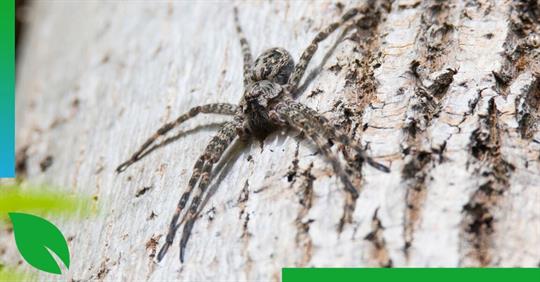There are many kinds of spiders throughout the continental United States. None have a more infamous reputation than the black widow, but another common species may be haunting your nightmares this Halloween — the wolf spider.
Identifying Wolf Spiders
Wolf spiders are fairly common across the United States. There are over 200 species of wolf spiders, different in size and appearance. The largest species can grow to be up to an inch and a half long but can also be only 10 mm long. Wolf spiders have hairy bodies and are typically black, grey, and brown in coloration.
Wolf spiders reside so many places in the U.S. because they make their burrows in open grassy areas. However, wolf spiders will overwinter in homes or garages — typically somewhere near a door, window, or basement.
Are wolf spiders dangerous?
Wolf spiders may look menacing, but they pose no major threat to humans. Wolf spiders will only bite when threatened, so if you follow the golden rule of pests and steer clear of them, they’ll steer clear of you.
How do I get rid of wolf spiders?
Even though wolf spiders aren’t dangerous, you may still not want to share your home with them. So how do you get rid of wolf spiders?
Do’s and Don’t’s of Wolf Spider Removal
Removing spiders from your home can be simple when you know what situation you’re dealing with. Follow these tips from the University of Kentucky to deal with wolf spiders at home:
Don’t Squish Them
First things first, you never want to try and crush a wolf spider to death. Why? Female wolf spiders differ from other species of spider — both in how she lays and carries her eggs. The female wolf spider will carry her eggs with her on a part of her body called “spinnerets”. When the spiders hatch, they stay attached to their mother until they’re large enough to hunt on their own.
If you attempt to squish a wolf spider that happens to be a hatchling carrying momma spider, you may face the nightmare of releasing hundreds of baby wolf spiders into your home or property.
Clean Your Home
Vacuuming regularly picks up insect parts that may be appealing to spiders looking for an easy meal. It also prevents crumbs from attracting other pests that may make a good dinner for a wolf spider. Without a food source, spiders won’t stay in your home.
Marie Kondo Your Mess
All pests like to seek out dark spaces to shelter in over winter, but wolf spiders, in particular, may be attracted to the more cluttered corners of your home or garage. Sort through your things and pack them away cleanly to reduce the hiding spots for spiders.
Practice Good Lawncare
Cleaning up doesn’t stop inside the house! Piles of leaves, firewood, overgrown shrubs and bushes, and even fallen tree branches can create shelter for a wolf spider making their burrow. Keep your yard clear to better reduce the chances a wolf spider will take up residence inside or outside your home.
Seal Gaps and Cracks
All pests can gain easy access to your home through gaps in door and window frames. Other areas spiders and pests may access your home include:
- Breaks in brick
- Gaps around water and waste pipes
- Cracks in drywall
Make sure your home is sealed properly to prevent unwanted guests this winter. Bonus, it will also improve your home’s energy efficiency!
Turn Off the Lights
Did you know porch lights attract pests? You’ve likely noticed moths and other light-seeking insects hovering near your front door when the porch light is on. This is a great source of food for spiders. Turn the lights off at night, or change the bulbs from incandescent bulbs to yellow bulbs to reduce your home’s attractiveness to night insects.
Whether you’re at peace with pests or living in a waking nightmare anytime you see a bug, getting rid of spiders can be a chore. Contact the pest control experts at Enviro-Tech Pest Services to help you rid your home of spiders for good! Contact us online or by phone at (800) 836-3089 today.

